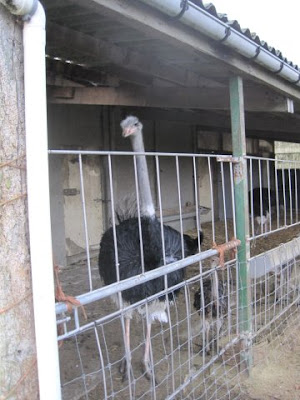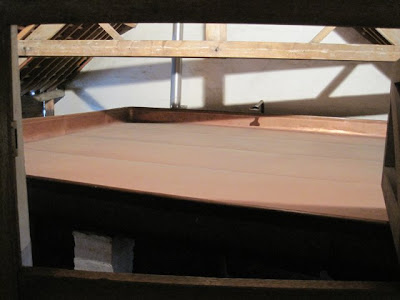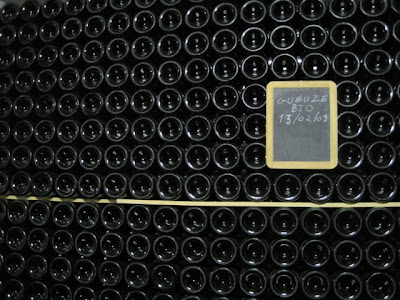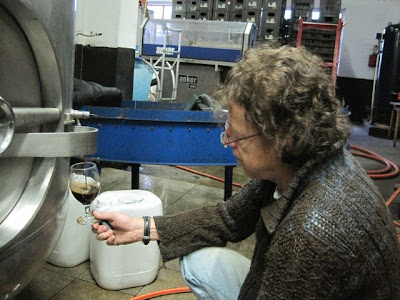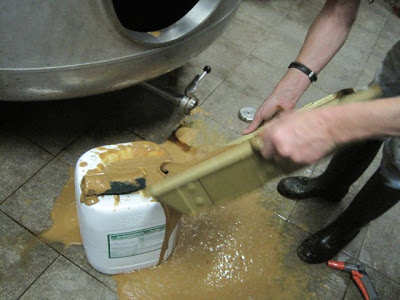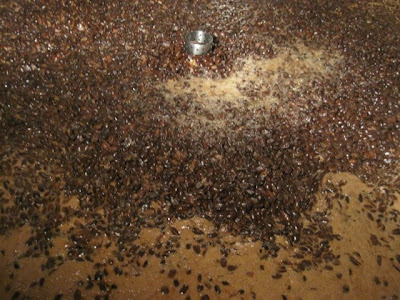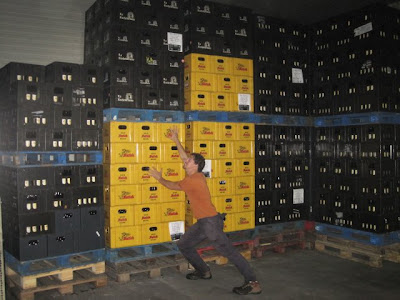Thursday, November 26, 2009
Stuff Your Turkey With This
But, I'm having a truly wonderful time here in France. It's been about a week and a half since I biked against a brutal wind over the border to the charming village of Esquelbecq and, despite the even more brutal wind and rain we've had here, I've been having a great time.
The past week has been full to the brim. We brewed Blonde d'Esquelbecq and Rouge Flamande, did quite some bottling, labeling, and packing, and prepared for a little 'exposition' nearby, reminiscent of a sizable American crafts fair. I had my eye on a nice, handmade leather revolver holster. Just for looks.
I spend the days, mostly 8:30 to 5, in the brewery that sits in the backyard of Daniel and Marielle's handsome old farmhouse. The brewery is new, built around 2006, and orderly but not dull. It's all open and windows and a garage door allow in plenty of sunlight (when the sun decides to shine). There's an office with the computer's brewing program buzzing and blinking away; four massive fermenting tanks side by side, the mash tun and boiling kettle, a hot water tank, three small CIP vessels, and mazes of pipes and tubes and hoses. Each day in the brewery is a little different, but Daniel has the automation down to an art, if that's possible. I'm there to mill grain, hold hoses, weigh hops, label bottles, taste-test, and squeeze all the brewing trivia from Daniel. Today I got to climb atop all four fermenting tanks to spit-shine their stainless-steel domes. That's a good 30 feet up on slippery steel, but I survived. Brings me back to my climbing days, when I almost paralyzed my buddy Tim.
Anyway, I'm learning a lot about working in and operating a small brewery. But that's not the only entertainment. Living with Daniel and Marielle has been splendid. The old house is scootched right into a nook by the center of town, so it's not too isolated, and the red-tiled roof, decorative interior, and flowerful yard make the living experience lovely. Daniel, Marielle, and I are having fun working on each others' languages over hearty, warming meals and great beer. It feels a bit like home. Of course, we don't stay cooped up every night. A few nights ago we tried our luck at a couple bars. On our way to a bar next to Brouwerij Van Eecke (kind of a disagreeable website...) in Watou, Belgium, we stopped by Café des Orgues. Words can't describe the bizarre yet fascinating experience. It's a bar with an open dance floor and three giant, grandiose, automatic organs. Just YouTube it. Another night found us at a private pre-performance by a trio of talented Francophones. Clar Vox consisted of a pianist, clarinetist, and jaw-dropping soprano, and together gave me the shivers. The performance was held in a 17th-century gunpowder production room formed from white brick and complete with old gunslots in the walls.
Tomorrow we'll be visiting a cinema and watching a silent film the way they used to: with a live soundtrack. More on that next time!
Friday, November 20, 2009
Thiri... eh?
…OK, didn’t get to publish that last paragraph until now, several days into this recent sojourn. Well, it’s been awesome. Brewed Ambrée d’Esquelbecq on Tuesday; dawdled around the brewery on Wednesday, waving hoses and bottles and labels around, hoping to make things clean and prepped for brewing, bottling, and shipping; bottled Blonde d’Esquelbecq and La Rouge Flamande today. Daniel’s brewery is something special; a visionary blend of small-scale production and efficient automation, it welcomes you with its homey comfort but eases the brewers’ burden with partial computerization and a CIP system (cleaning-in-place). It’s absolutely not industrial, despite this. And the beers that Daniel brews are full of character: fresh, balanced, quaffable, with a house yeast character that is at once cozily appetizing and zestily wild.
Daniel harvests the yeast
That’s a quick update for now. Tomorrow’s another brewing day with a musical treat in the evening that has nothing to do with brewing. I will serve you in due time, dear reader, with more about this picturesque brewery amidst the northern French countryside.
Dominique steam-cleans an old keg
... Another update: today is the day I just wrote about. Couldn't get to a computer. Well, today we brewed Blonde d'Esquelbecq and tonight we'll be going to the concert! Marielle served a scrumptious salmon, egg, and ham salad this afternoon tossed with her home-made dressing. Rochefort and aged Gouda topped off the meal as well as a taste of paté made with Daniel's Ambrée. Yum.
Intestinal Tranquility in the Fields of Flanders
The other day I was out on my semi-daily run. It had been a long day at the school, building a second floor in one of the rooms for an office, and it was dark when we rolled back to the farm, but I still felt the urge to expend some energy. So, I suited up in my spandex cow-print skiing suit I use for running in chilly weather (didn’t return it to my high school ski team…), put some layers over it so I didn’t look like a complete jackass, and set off along the backroads of Lo (they’re all backroads). I knew something was up as soon as I left, though… I knew I shouldn’t have eaten all those peanuts at the school…
Well, it was going smooth enough, I had made it about halfway through the 14 km loop, my headlamp bobbing and spraying light ahead of me so I could see where I was. I knew something was up, though, as soon as those first rumblings deep within started. It was mild at first, but then came the crippling ones. You know, the kind that stop you dead in your tracks, make you clutch onto a handrail and raise your eyebrows for that “Oh, shit” look…
I had just turned off from a main road, passed a barking backyard dog, when the point of no return hit. There was no way I was making it home before something terrible happened. I scrambled into a narrow strip of trees and brush by the (luckily) quiet road, tore through brambles and thorns, and pinballed off trees to reach seclusion. Struggling with the damn cow suit was an epic battle; I couldn’t just ‘drop trou’ and let loose. No no no, I had to remove all those layers, zip down the middle of my torso, peel my arms out of the sleeves, and get free. Five layers in all. Well, with a fraction of a second to spare the duty was done. I was a free man. No sign of a struggle, no incriminating evidence. I had succeeded in the most harrowing of situations, against all odds, and at the same time revived a lost art once intimately entwined in human behavior. It was an epic forest-shit.
This has nothing to do with the story, but this is my (Phil's) barnyard drumset
Sunday, November 8, 2009
Right or Ranke
I shadowed Guido on Friday as he brewed XX Bitter, Belgium's first popular bitter beer and an incredibly crisp, zesty piece of work. It's got some great floral hop character in the nose and a special Belgian spiciness from the yeast. I got there at the ass-crack of dawn as the grain was being hoisted dustily into the mill; malt boogers don't make a complete breakfast. After the mash Guido ran the filter from several drains in the mash tun. The first runnings of the wort (the "malt tea," essentially) are usually cloudy due to suspended malt particles, but eventually the wort runs clear as it's filtered by the husks of the grain. We had a 20-minute delay when the wort coughed and started to run cloudy in the middle of the filter, but, as the Belgians say in their ebullient English accent, it was "no problem."
Saturday was a bit monotonous, wrapping paper around hundreds of stylish De Ranke bottles, but there was company and a retro stereo that played half Belgian pop and half American hits from two years ago. Some lucky Americans will be getting some XX Bitter wrapped by blue-blooded American hands. Noir De Dottignies, their dark, bitter stout-ish option, and Guldenberg, a solid strong blond named after local abbey ruins, were also wrapped and bound for USA. Meanwhile, Guido and Nino bottled their Christmas sipper Père Noël, spiced with just a tingling touch of licorice.
I was starstruck for a second, too. Well, it happens with all brewers, but this time it was an author. Yvan De Baets has authored some books about beer and I had just finished Farmhouse Ales about traditional French and Belgian agrarian refreshers, to which he contributed a chapter. He was there with Bernard Leboucq, and both are brewing their own beers at De Ranke under their Brasserie de la Senne label. Luckily I had been wasting my life away on youtube recently and had seen him exploring some German beer caves, otherwise he would've just been another mysterious brewer.
The bucolic Mediterranean crags and shores of Italy beckoned me on Friday night. Guido and Nino were kind enough to invite me along to an Italian beer tasting led by the country's finest beer ambassador, Lorenzo Dabove. 'The Prince of the Payottenland' gave the local beer club several samples of Italian beer whilst waxing poetic about each and expounding on their emerging craft beer scene. While I have to say I wasn't entirely impressed with all the beers (some were funky, some were flat), I applaud the creativity and spiritedness overall and the raw quality of some. Macca Meda, a new beer from Birrificio Barley (Sardinia), was fantastically hoppy, crisp and characterful, a cousin to American IPAs. Chocarrubica from Grado Plato (Turin) stole my heart, though; a moderately strong oatmeal stout with cocoa beans and carob? For a guy who actually enjoys - no, craves - carob? C'mon, it's an easy win. Thanks again to the De Ranke dudes for the insider weekend and beer tasting.
Thursday, November 5, 2009
The Ostrich Farm
I just spent my fifth night on the Struise farm, though the first night only lasted about four hours, but I can already tell what an unbelievable time I will have here. Amidst the ostriches (which I, by the way, cannot do justice in writing to their bizarreness) and Scooby, the big slobbering Great Dane, sits a U-shape of buildings. To the left is Urbain's pad, where he and his daughter Lorence live and where I will sleep when the bed and breakfast is full. Straight ahead is the bed and breakfast, where I have a room when the place is empty. Well, even in my room there are several rooms. In fact, it's really a condo, complete with three beds, leather sofas and chairs, TV and VCR (in case I need to watch some movies from the 80s), a kitchen in case Urbain's cooking goes to hell (not likely), and a cupboard of beer glasses (no, not for the eyes; I can see well enough, thank you). Downstairs is the common room, where the only thing I needed to see was a small wood stove and a comfy armchair for those stormy winter nights.
The Geeks at Beer School
To the right of the B&B is Phil and Daisy's house. Daisy, Urbain's sister, runs the B&B and Phil helps Urbain at the brewery in addition to a job in a nearby restaurant and as a Citroën dealer. Both have been entirely friendly, especially in keeping Scooby from drooling on me. Phil and I instantly connected over music as well; turns out he's as big a fan of the drums as I am and even has an old dust-covered drumset in the barn in case I need to feel like a rockstar. I'm in the works to organize a brewhouse band; Lorence is a multi-talented musician and Urbain says Carlo is musically inclined as well. Bono says he won't sue if we call ourselves Brew2.
Just chillin'
Oh, and there's another living space on the farm. Urbain's Berlingo van is actually an officially recognized apartment, and this is where he performs most of his daily grooming and domestic tasks. Let's see, he's got several phones, a wardrobe of clothes (even new shirts and everything), an assortment of food in various stages of decomposition, footwarmers, mouthwash, his electric razor (which is his favorite device to use in the car – he shaves at least 3 times a day just for kicks), a shower, a plasma TV, and several cats. On the way back from De Molen I got to know not only the car but also Urbain quite well. Urbain's wit is razor-sharp, his philosophical ideas are contagious, and his knowledge of and interest in biology and evolution is reviving my love for the subject. And we like to apply it to our discussions of Belgian women.
Black Albert Batch 0
A few days ago was a lazy Sunday, but it was just what we needed after some tough days in the brewery and the busy, beery buzz that was the De Molen fest. We had a few visitors: three Brits, “The Geeks” as Urbain fondly calls them, and an American visited the schoolhouse brewery for an afternoon of shit-shooting (...that's an American expression... we didn't actually shoot any shit around...) and Struise sipping. The Geeks - Ian, Mes, and Ken - are real connosseurs. They're probably some of Britain's finest beer raters and proponents, and they're huge Struise-heads. We had a beautiful Black Albert vertical tasting with a few additional samplings as well. Starting with the freshly-bottled Black Albert and the newly-refined Black Damnation (2/4 Black Albert aged on 5kg Columbian aromatic coffee beans, 1/4 Black Albert aged in Jack Daniels barrels, 1/4 Hel & Verdoemenis), we moved on to a terribly tasty experiment that involved a special distiller's edition Caol Ila single malt Scotch whisky matured in Moscatel cask wood. Taking a row of Struise beers – the new Black Albert and Black Damnation, Cuvée Delphine, Black Albert Batch 0 (the first batch, from 2008, pulled from a near-empty keg), and Double Black (Black Albert that had been frozen to remove some water, making a 29% abv masterpiece) – Urbain swirled just a couple drops of the Caol Ila in each glass and mixed in each beer. Each blend gave an incredible result, the whisky contributing a touch of its vanilla and peat character and refined aroma. The Double Black, even without the whisky, was just mind-blowing, like a silky smooth chocolate/coffee/dried fruit liquer, only ten times better. The whisky experiment was making Urbain's brain visibly whir and his hair stand on end, so you can probably expect to see some Caol Ila oak-aged product on the market sometime soon. Lastly, we sampled a year-and-a-half old Dirty Horse. Dirty Horse is Urbain's first beer that captivated him and motivated his move into the beer world. It's a simple recipe, brewed with a portion of wheat, that's extensively open-fermented and inoculated with wild yeasts. Later matured on cherries, it resembles a kriek lambic but has such a complex Brettanomyces kick and dazzling finish that many consider it to be Struise's absolute best beer. It was the icing on the cake, and The Geeks finished their last drop and went on their merry way.
A Day in the Orange Land
Yours truly behind the bar
This Borefts Beer Festival brought together Belgian, Dutch, Swedish, and Danish brewers; Struise and Alvinne represented Belgium. De Molen and Emelisse had home-court advantage, Närke Kulturbryggeri batted for Sweden, and Mikkeller carried Denmark’s flag. Glenn and Davy drove me in the Alvinne beerwagon and two additional helpers squeezed in as well; Stephan to my left and Mark to my right. Urbain took his mobile apartment separately.
Davy points to something. Höge's on your left.
Brewers started serving at noon, when only the real hop-heads showed up to pace themselves through the day. A good Dutch representation mingled around the booths, joined by a handful of Brits and a couple Americans. Everyone spoke English with a little cajoling. The atmosphere was relaxed, the day was clear, and De Molen had a food service in action, so folks were fat and happy. I asked for some cheese and they gave me enough to feed an army – and it was good, too! Cheese comes cheap in those parts.
The Mikkeller crew (Greg Gaughan's photo)
Urbain, Glenn and Davy worked their brewmastery on the floor for a while, but when I was relieved from my pouring duties I was able to mingle among the crowd and show off my American accent. Soon, though, I stumbled upon the Närke table. Höge (I think his name was) fit the perfect mold of what I thought a Scandinavian brewer should be. He was short, stocky, sported a wide gray beard and round glasses, and wore a leather cap and vest. All black clothes. His demeanor was far from intimidating, though, and I soon got into a discussion about our mutual disdain for all the heavy beers that are put into huge bottles. He’s pushing for small bottles for his dark, thick concoctions, so we can drink for the taste and not for the buzz! I was able to sample Tanngnjost & Tanngrisnir, a bock beer brewed with juniper clippings and smoked malts. It has quite a history, Höge said it was brewed in better times (before Christianity), and his interpretation was magnificent. Certainly spicy and a bit puckering, it possessed a great malty backbone that blended with the juniper superbly. It was named after Thor’s two goats, and I think the man would’ve been proud. Maybe he would’ve given Höge an honorary degree in godliness, knighted him with the hammer. Other highlights were Närke’s Kaggen Stormaktsporter (both 2007 and 2008), this year’s best beer in the world, Mikkeller’s 黑/Black (I’ve heard one sip in the morning is enough to keep you going until lunch, at least), and Struise’s Dirty Horse. Dirty Horse is a kriek-like beer that Urbain first brewed in 1983. He built a makeshift coolship out of timbers and a tarp and let the wild things do their work, later aging the brew on whole cherries. This particular batch had been aged for four years; it took six hours to disappear.
De Molen's brewroom
And that was about it. The Struise/Alvinne crew had a pleasant sleep at a bed and breakfast and drove the two hours back to the homeland.
Cantillon
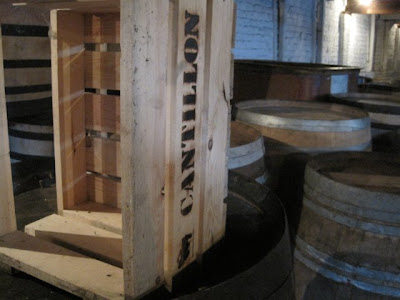
Just outside the center of Brussels, where hustle and bustle, business, and grandiosity reign is a rough diamond of Belgium that needs no shining. The Cantillon brewery, under ordered chaos, has been producing spontaneously-fermented lambics for around 100 years. Patience, creativity, and instinct are virtues for these brewers of highly traditional, complex Belgian beers. I visited Cantillon, tucked away along a quiet side street near Brussels’ south station, for a self-tour of the ‘lambic lab.’ I was greeted and lectured about the importance of preserving traditional lambic brewing practices by the sister of the brewer, Jean-Pierre Van Roy, who, along with her brother of course, descends from a long line of lambic brewers. As I listened to her recitation, my eyes wandered to a row of elegant green 75cl bottles. Unblended lambic, geueze, raspberry and cherry lambics… tart, juicy tonics… I drooled a bit onto my shirt and snapped back to reality, quickly thanking Ms. Van Roy and shuffling off to begin my tour. A couple samples awaited me at the end.
Copper coolship
I zigged and zagged around the corridors and stairs and attics of the dormant brewery. Cantillon does not brew very often and is limited even further by the fact that traditional lambics are only brewed during the winter months; summer can bring too many overactive, acidic wild yeasts and bacteria that turn the beer into vinegar. I asked Jean if he ever considered producing vinegar, and I got a slap in the face. First was the room housing the mash tun and the upper level where milled malt and raw wheat are fed into the tun below, along with aged hops that have lost their bitterness but retained their preservative qualities. Aged hops can smell a bit cheesy, and I had to bend over and sniff my boots a couple times to make sure the smell wasn’t me. Well, I contributed a bit. Another floor held a stock of unused barrels and bags of malt and wheat and a half-floor above boasted a sign announcing that the next room was the most important of the brewery. It housed a large, shallow, open copper vat flanked by rows of windows to the outside. The wind whipped and whistled and a brisk wind raised goosebumps on my arms. This copper vat was the coolship, where wort is pumped to cool overnight. Meanwhile, those sneaky bastard wild yeasts find their way into the sweet wort and begin their massive micro-organismic orgy. Over years, these horny cowboys will continually reproduce and eventually consume nearly all the sugars in the beer, from the shortest to the longest-chain. Different strains of yeast and bacteria act at different times but in the end the beer is extraordinarily dry – no residual sugars.
Barrels galore
All that talk was making me hot, so I moved downstairs to the maturing room. Barrel after endless barrel filled every nook and cranny; the fruity, funky smell of lambic cut through the air and singed my nostrils. Something in the dank, dark corner hissed and I clutched the Glock 9 in my back pocket, but it was just a barrel with over-eager fermenting lambic. Luckily, I haven’t had to use my piece in two years of brewery tour service.
The hissing barrel
Finally, I brushed past the cobwebs and sneezed through the dust to find the tasting room. A small wood stove emanated its tinglesome warmth and I cradled half a glass of Gueuze (almost pronounced "gooze," but keep your lips tight), a lively blend of old and new lambic. Next came the Kriek and then the Rosé de Gambrinus, two lambics refermented on cherries and raspberries, respectively. The extra sugars in the fruit get those yeasts in the mood again, and they go at it like dogs in heat. Well, after these samples I felt strength again to find my way back to my host's house. It was just the boost I needed to face Brussels' public transportation system...
Organic gueuze referments in the bottle
Sunday, November 1, 2009
It burns!!!
The first two days spent with Urbain were tougher than a Sudoku puzzle, master level. My deltoids and nose hairs burned the most, from loading endless bottles onto the bottling machine and climbing into tanks full of CO2 and ethanol, respectively. It's all in a day's work, though.
Last Wednesday and Thursday were two days of madness, even for that wild and crazy guy we call Urbain. He'd decided to brew and bottle in one day, something he'd never attempted. Pannepot was the beer to brew, and my first job was watchdog; the mash was finished and the filtering had begun, so I watched as gravity leached out the wort from the mash tun, turning on the pump when the reserve pit was full to transfer it to the boiling kettle. Urbain was in turbo mode, hair flopping around, phone ringing off the hook, limbs flying with pipes and hoses and cigarettes. I followed him around for the day, moving from the bottling line to the kettle to the conditioning area, back and forth. We weren't alone, though, a whole sturdy posse was around: I met Phil, Urbain's brother-in-law and partner-in-crime, if those are any different. Roger the codger was there, a nice older guy who owns a pigeon farm (didn't know those existed) and who uses the retired yeast as a supplement for his birds. Anyone for a Struise pigeon breast? Rich in vitamins!
The usual Deca guys were at Deca (where Urbain brews) as well - the patriarch and former brewery consultant in the Congo, Joe, puffing on his slim Swiss cigars. The following day was very similar, albeit longer for me. Wednesday was something like 9 hours; Thursday was a full 5am to 5pm. I was on the bottling line for much of it, fumbling around with the bottles at first... hotverdomme, they're slippery! I got into a rhythm, though, battling those bottles, and I conquered them at the end of the day - drowned 'em in Black Albert and a special Black Damnation, suffocated them with caps, branded their bodies with labels, and stuffed them into crates bound for the beer geeks in America. Willie helped out on the line as well, and whenever we had a problem (so, every couple of minutes) he would use his handiness to keep the machine and the beer running smoothly.
Well, let me tell you a little bit about this new Black Damnation. Black Damnation originally began as a collaboration beer with De Molen brewery in Holland: Struise's Black Albert and De Molen's Hel and Verdoemenis (Hell and Damnation) blended into one damn dark dastardly concoction. For this new Black Damnation, Urbain, in his infinite wicked wisdom, aged a portion of the Black Albert beer on 5 kilos of fine, aromatic Colombian coffee beans. The result was blended with finished H&D and bottled by yours truly and the crew. It has already turned into an absolutely epic imperial coffee stout. It could be marketed and sold in pharmacies as a low-dosage all-purpose tonic. It will be put on the red carpet for the opening of Struise's new school building brewhouse and educational center. Can't wait! I've got a special place in my heart for that beer, too, 'cause I got in that tank and scooped out all those sloppy beans and yeast and got caked with yellow coffee muck. Nothing like a good day's work.
Anyway, after two days of hard work and dried yeast still clinging to my clothes, I headed off with Struise, Alvinne and the Belgian brewing gang for a weekend at De Molen's first beer festival. Stay tuned...
A Week As A Tourist, With Some Help
Before I truly settled into Belgium, I decided to take some time to see a bit more of the country, branch out a bit. Y'know, I had been treating her well, taking her out to nice seafood dinners and all, but I needed a few one-night-stands. Not literally, of course... I was able to find some stellar couchsurfing hosts in Brussels first; Sarah and her family treated me like Bonnie Prince Owen as I roamed the streets of greater Brussels during the day and perched my cheeks on their couch in the evening.
My good friend Chris from Brown made an epic appearance in Brussels to visit me and the country for a few days, and we quickly turned Sarah's place into one big house of fun. Chris and I met at the Grand Place, of all grand places, making for a reunion of Hollywood caliber. Shortly after, we entered the subterranean level of the Grand Place's Brewer's House, where the brewer's guild of Belgium had its headquarters. It now houses a museum (informative but in need of some spice) and a little bar (cozy and friendly, and you never know what beer you will be served). We dedicated the rest of our stay in Brussels to walking on as much concrete as our feet would take while absorbing as much of the city with our eyes as possible. We even took a day trip to Namur, where Chris impressed with his French, we took an oddly bromantic stroll around the stunning fortified section of the city, and then returned to Brussels to cook Sarah's family a sneakily spicy Indian curry dish with potatoes and chickpeas. We could've fed a moose on the amount of food we prepared, but we managed to find all the ingredients (on a Sunday, no less) for under 8 €.
The next few days gave us more stories. Ghent was filled with a visit to the castle at Gravensteen, which was essentially a museum of torture as Chris pointed out. Highlights were a guillotine blade that had probably severed hundreds of unfortunate peasant heads, a torture device that had probably crushed thousands of agonizing tongue-holders, and several two-seaters that had probably been straddled by many hairy medieval bums, especially after all those Burgundian feasts.
Elsewhere in Ghent were our entertaining couchsurfing hosts, Elke and Miro, and a famous genever bar where Chris choked down a genever infused with hot peppers and I savored one spiked with the essence of God's best creation, Speculoos. After Ghent, which was lovely, we had to move on to West Flanders. I once again requested a stay with Wim from Poperinge and he, due to his awesomeness, once again accepted. Chris and I biked to In de Vrede, the café at Sint Sixtus Abbey in Westvleteren, home to that elusive and delicious beer. And some monks, I think. I felt a surge of ambition, too much in fact, because I ordered the traditional Belgian meal of hennepot, not knowing what I was getting into, only thinking that tradition is synonymous with tastiness. What I received was certainly a treat, especially after a bike ride, but it was a treat insofar as chicken suspended in unflavored gelatin goes. Which is what hennepot is. The beers, though, were fantastic. The blond was on the bitter side for its contemporaries, which I thought was great, and the 8 was like a light, malty plum stew, though it could use another half-year to peak.
When it was time to say goodbye to Chris, we agreed that our time was well spent. Chris took a flight back to Greece and I prepared to launch myself into my next adventure: life as an apprentice to one of the world's greatest brewers, Urbain Coutteau.
... chestnuts roasting in a big oil drum...
My last few days in France were mild, comfortable, and relaxing. I was integrated into the farm, I could work in the garden with very little guidance, I'd made friends with each and every rabbit even after they saw me "eliminating" their friends, and Jacqueline and Gerolf had adopted me into their rhythms. So it was a bit tough to leave; I'm particularly attached to routine. But we had a bit of fun before I took my train north to Belgium.
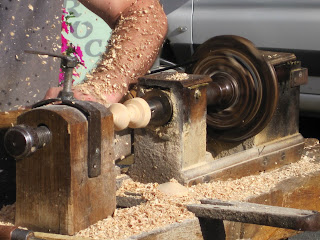 A woodworker turns a top on his lathe
A woodworker turns a top on his lathe
